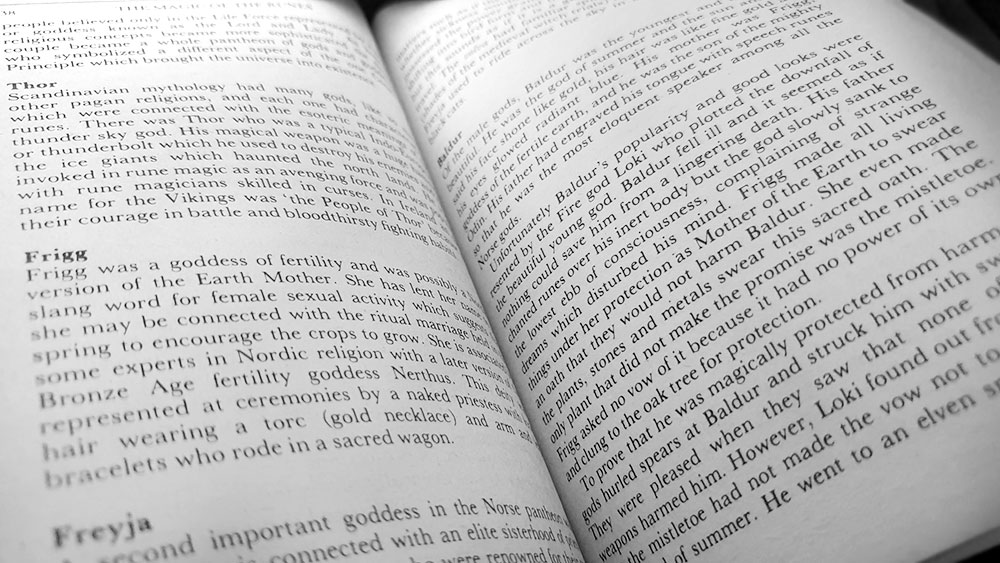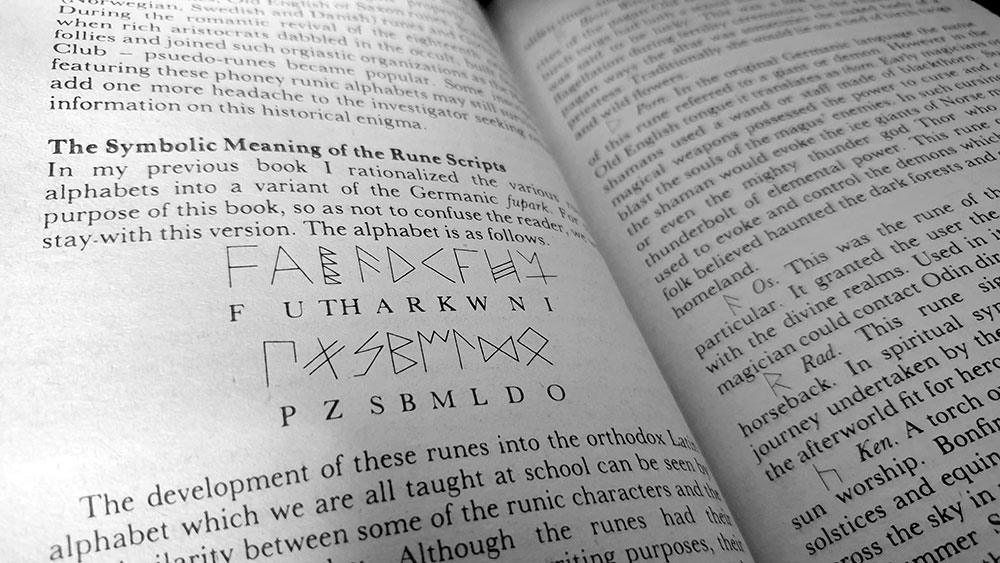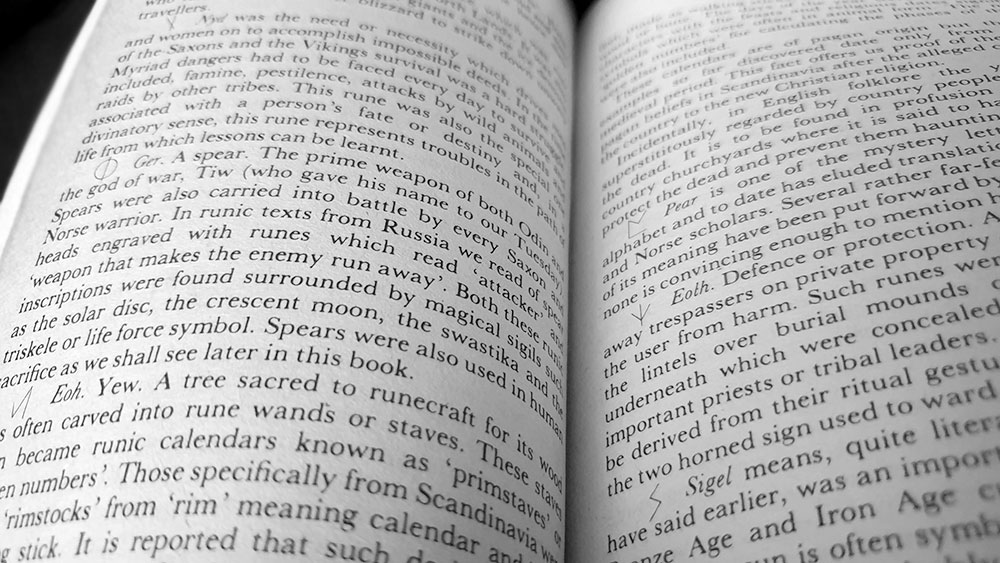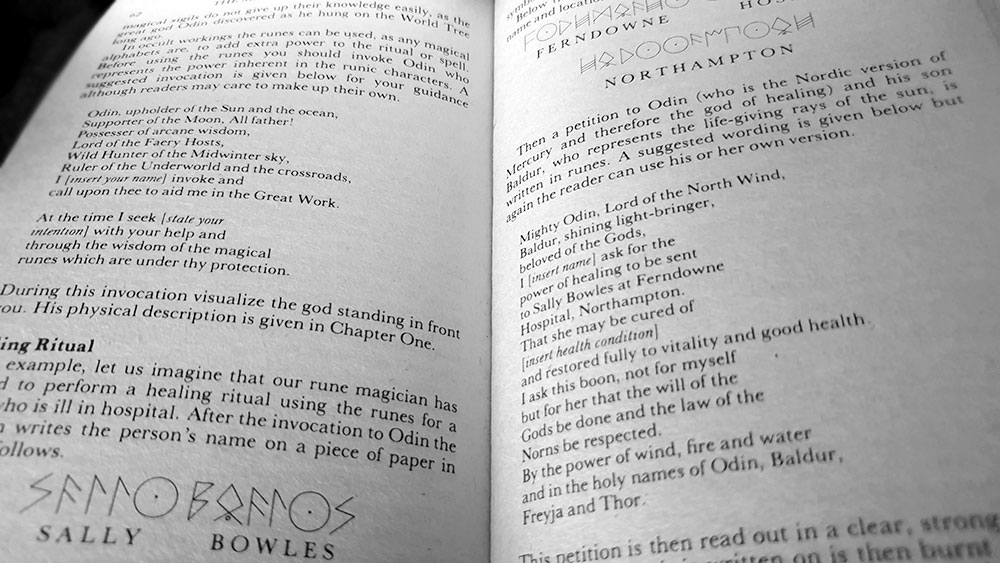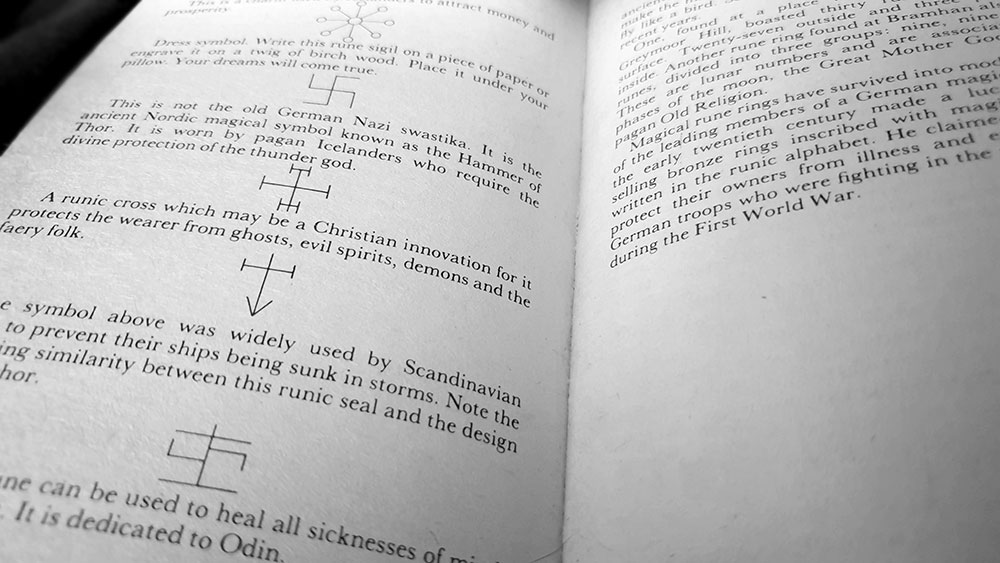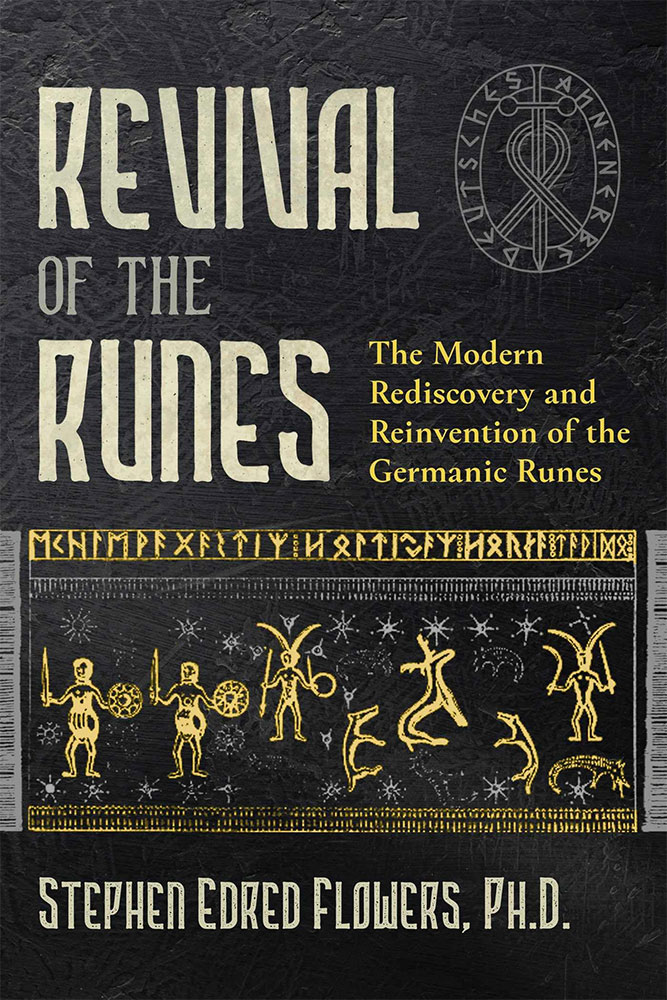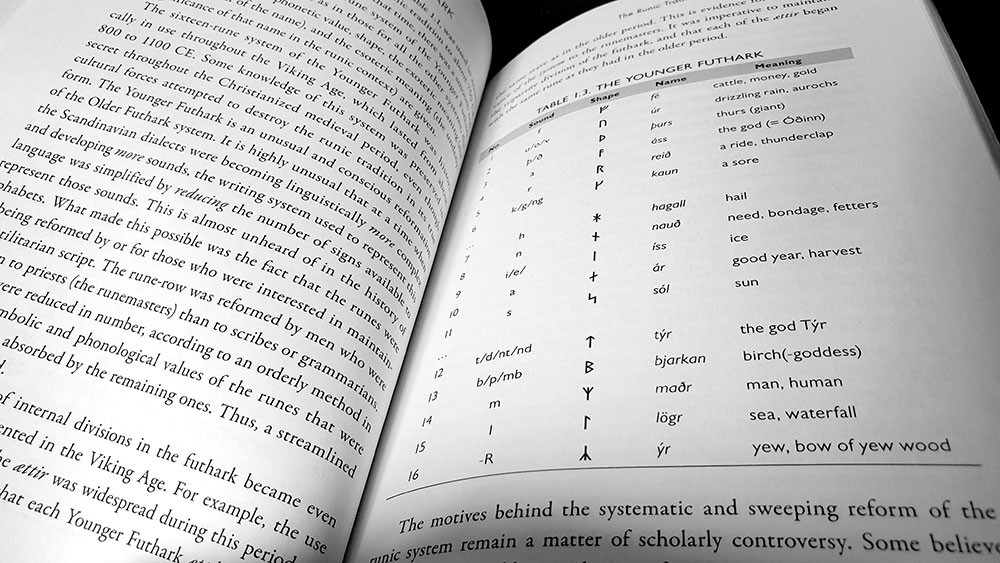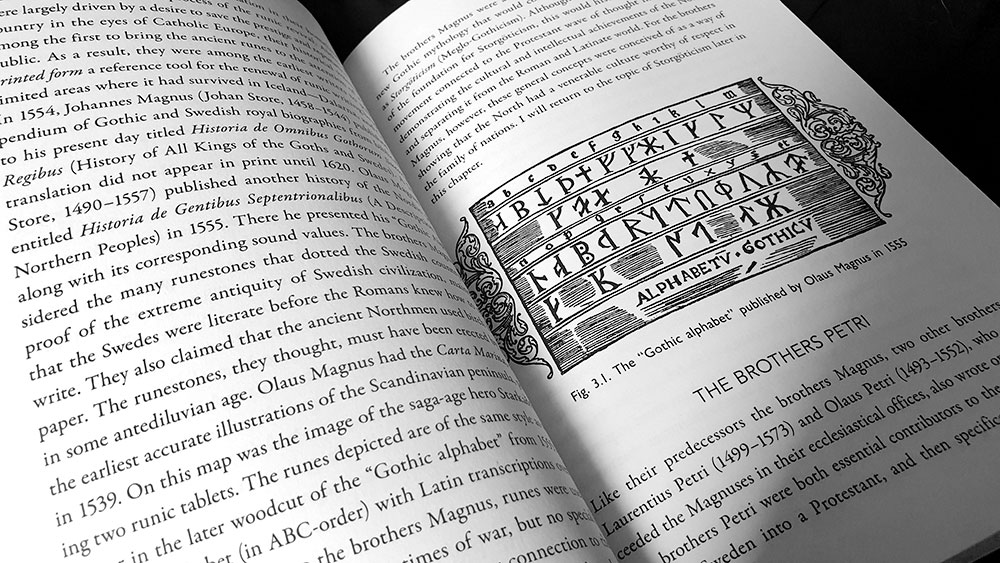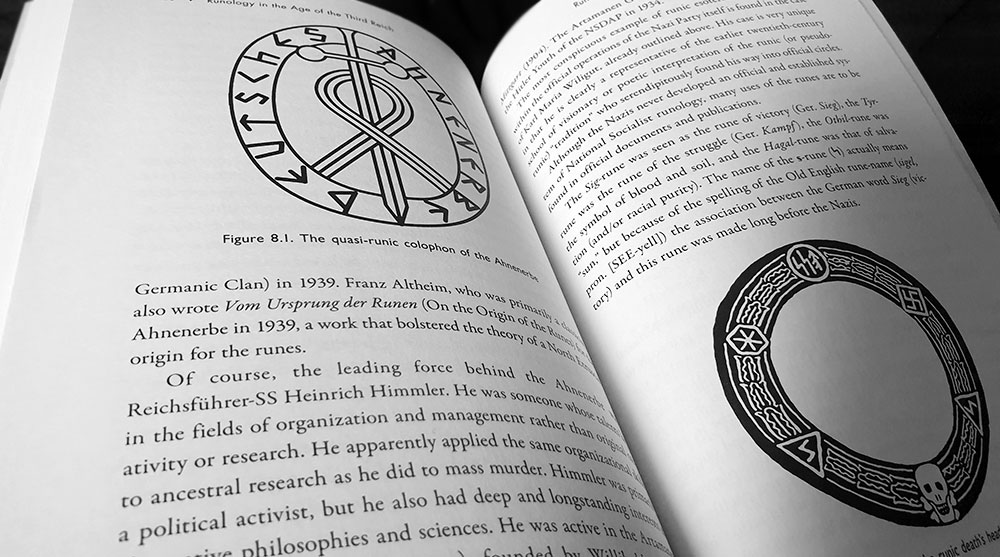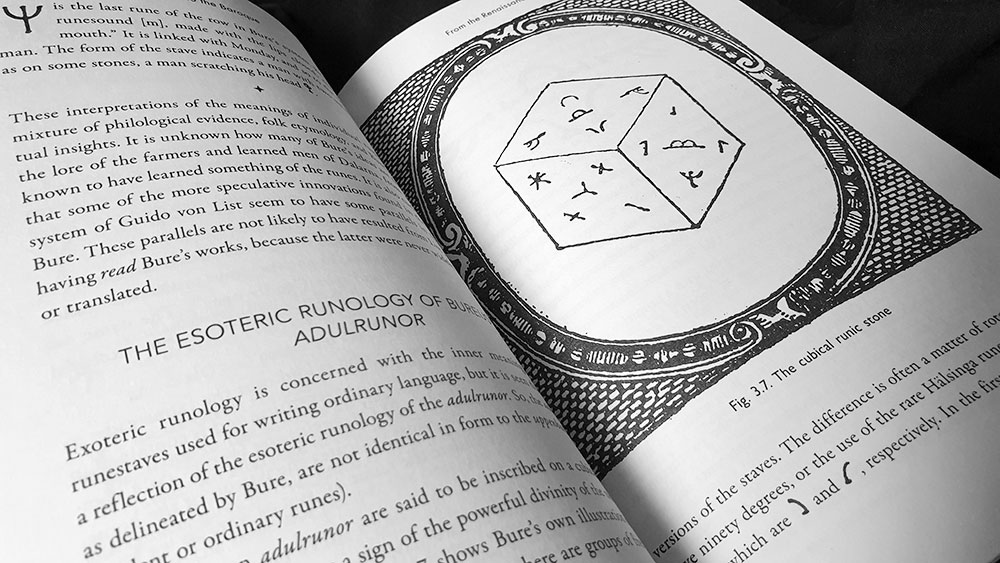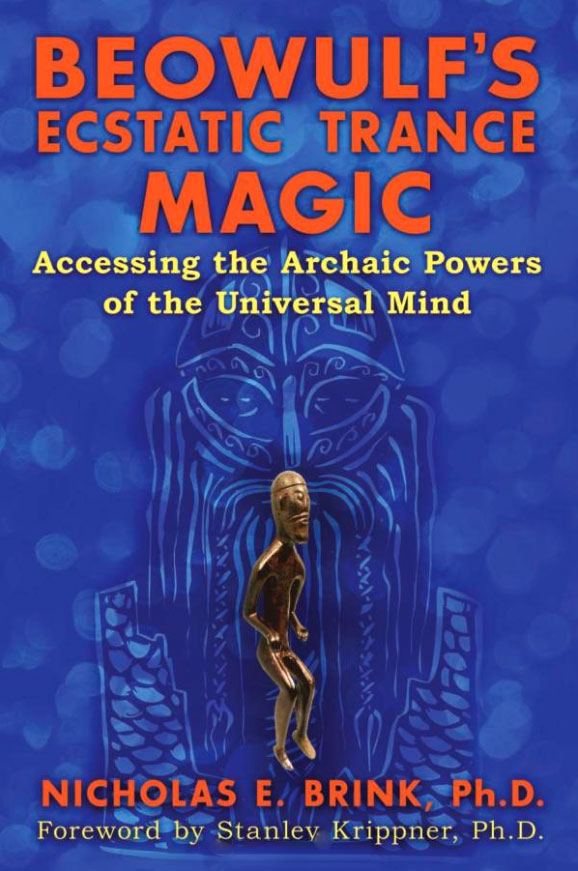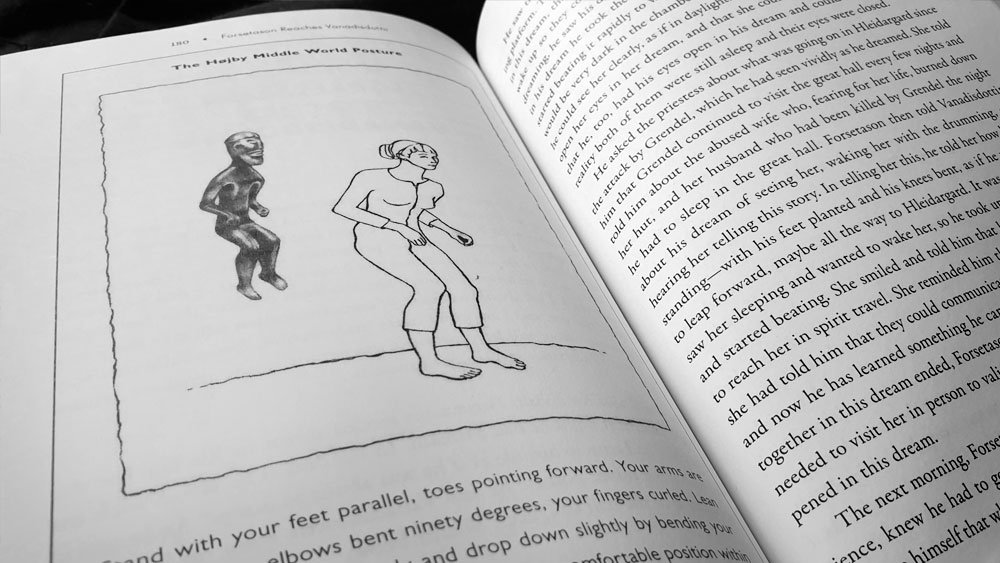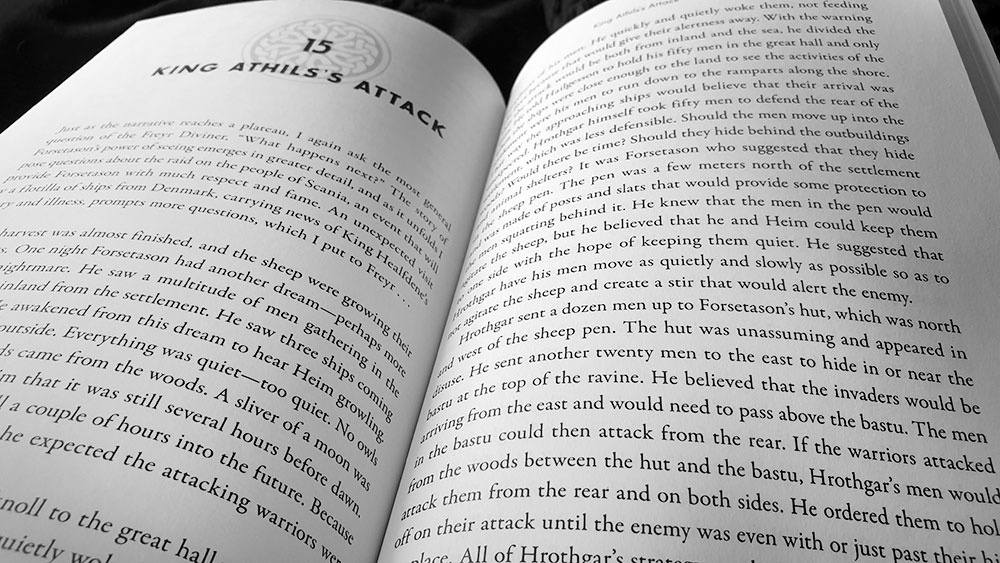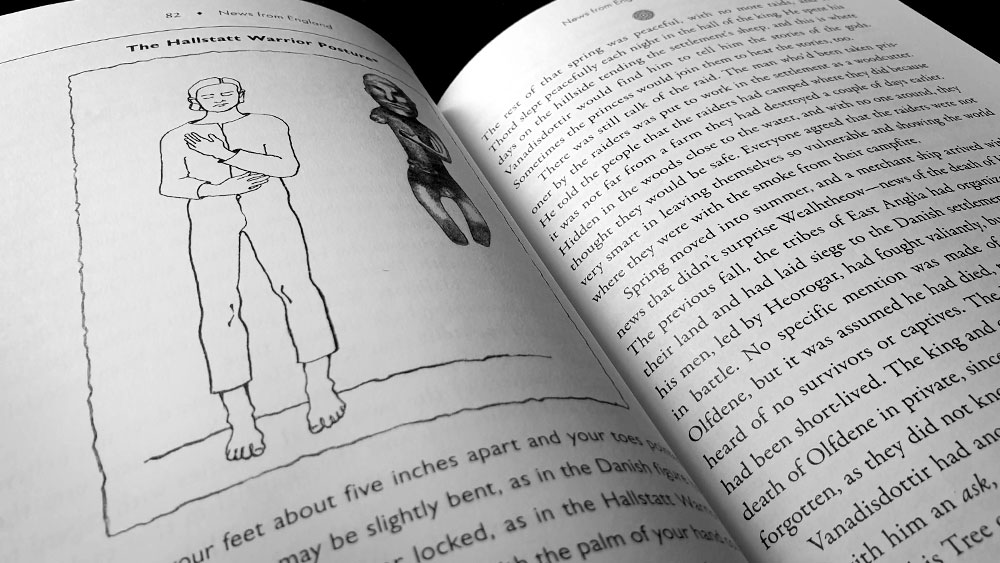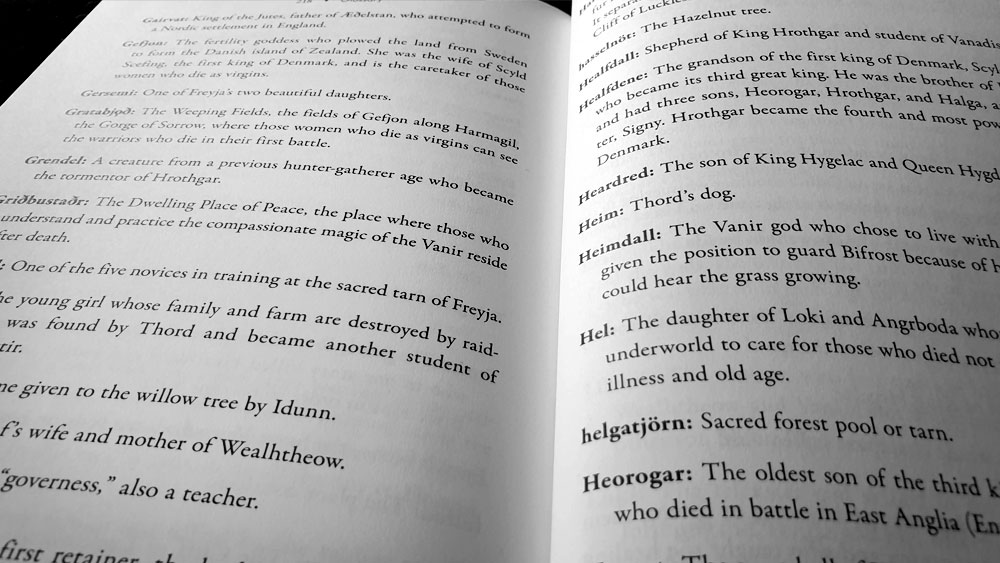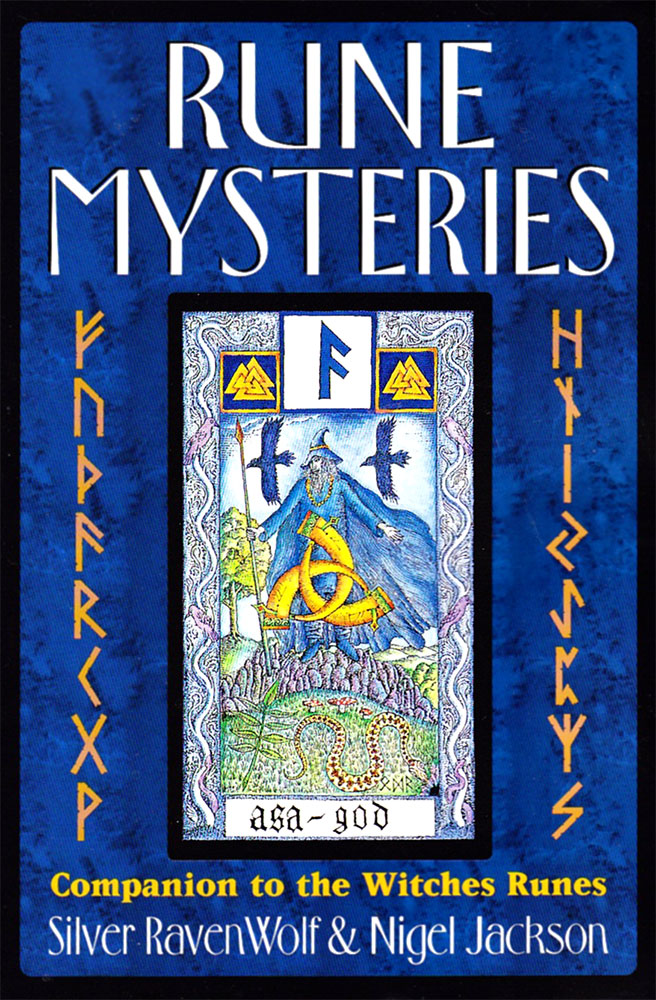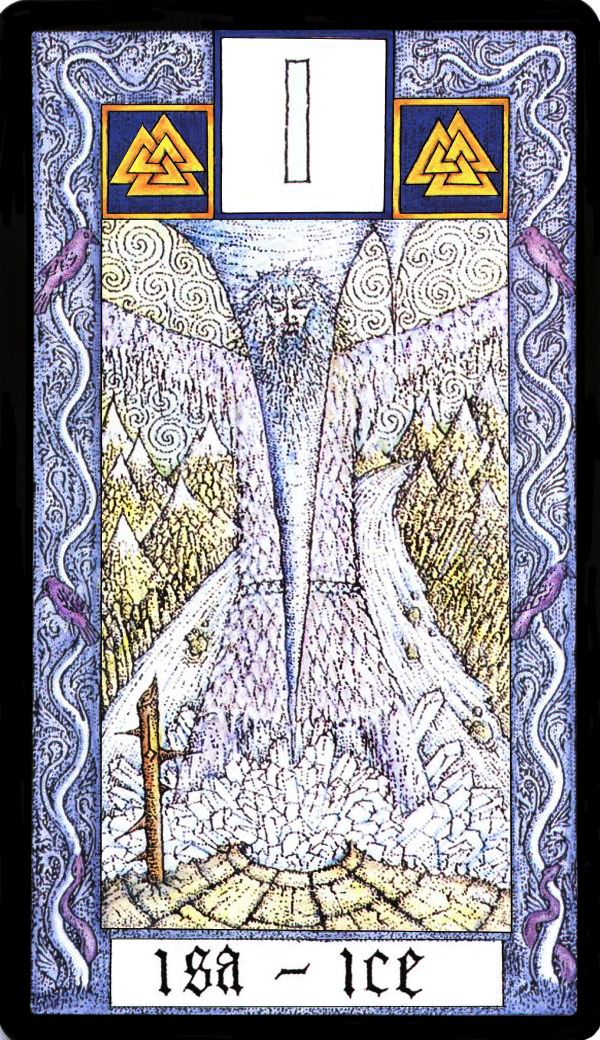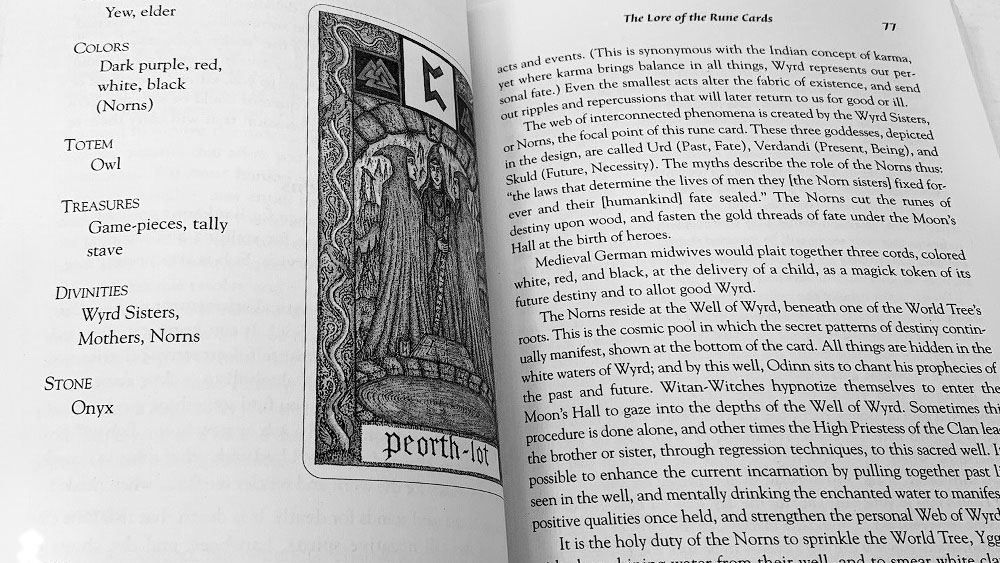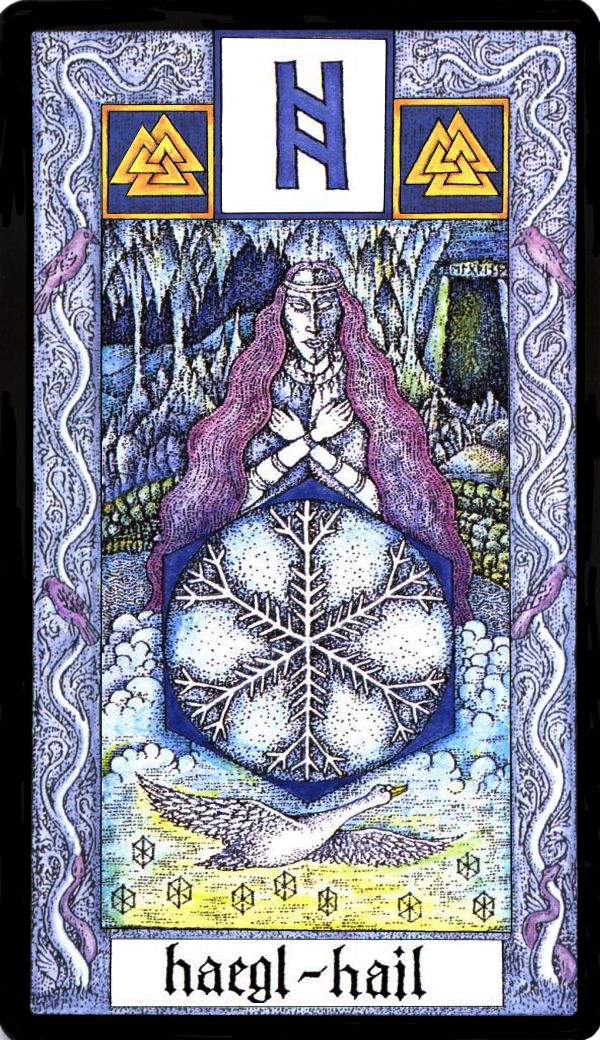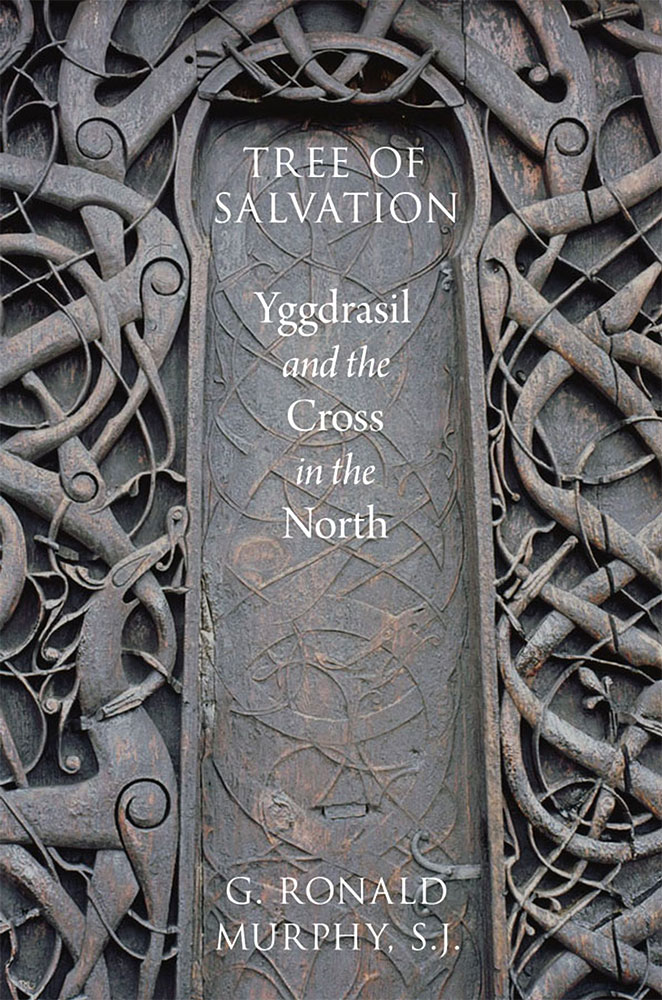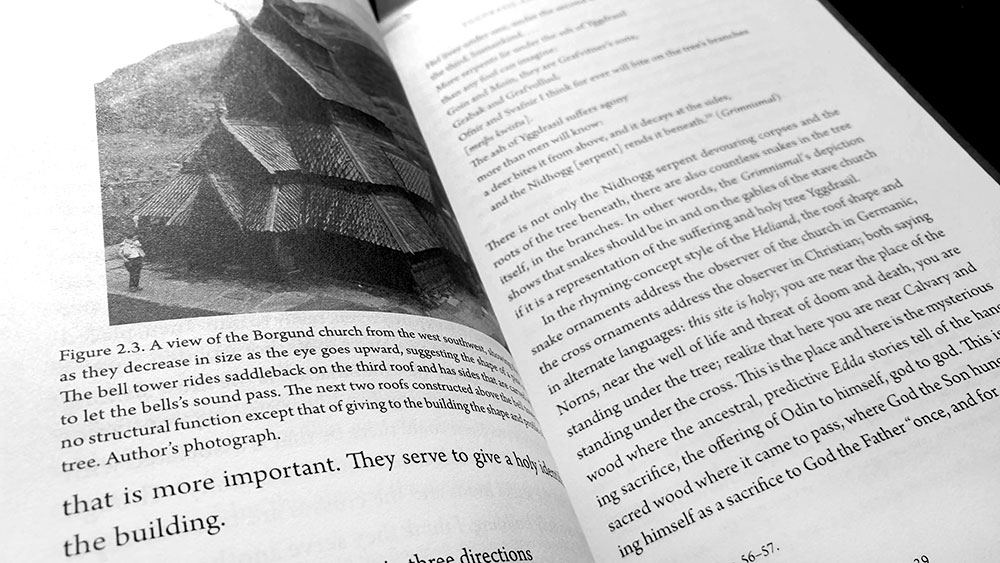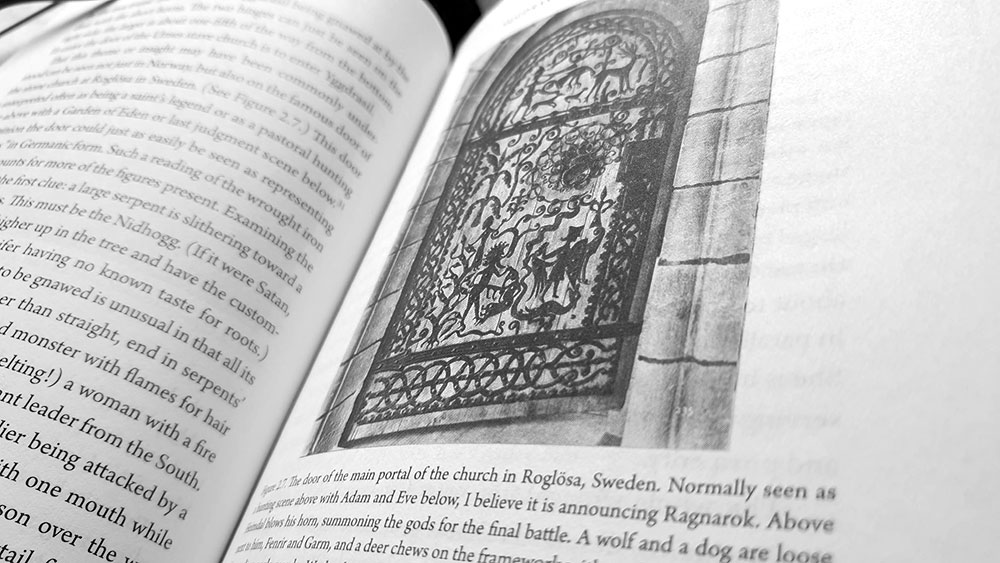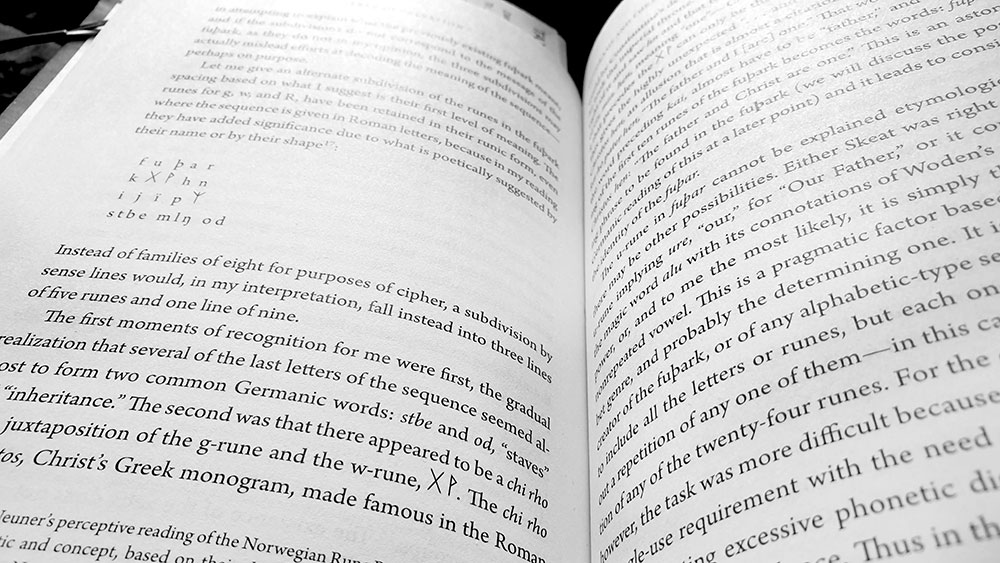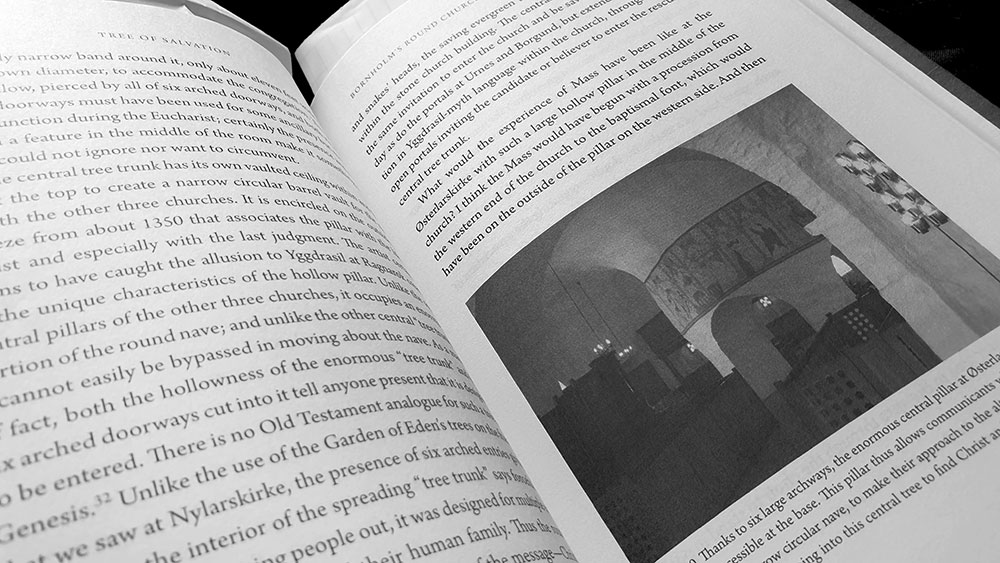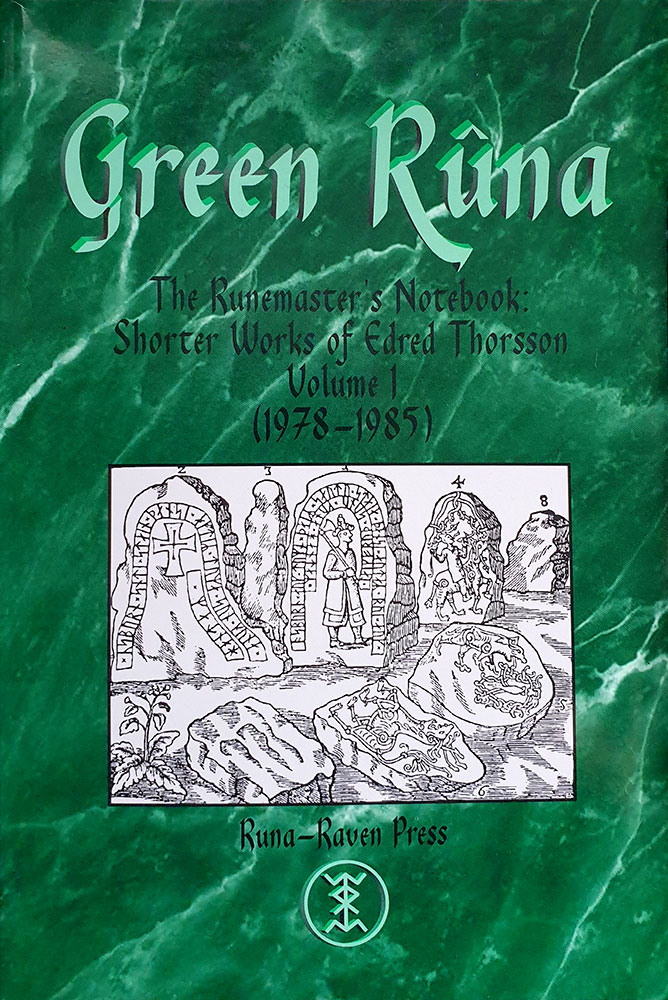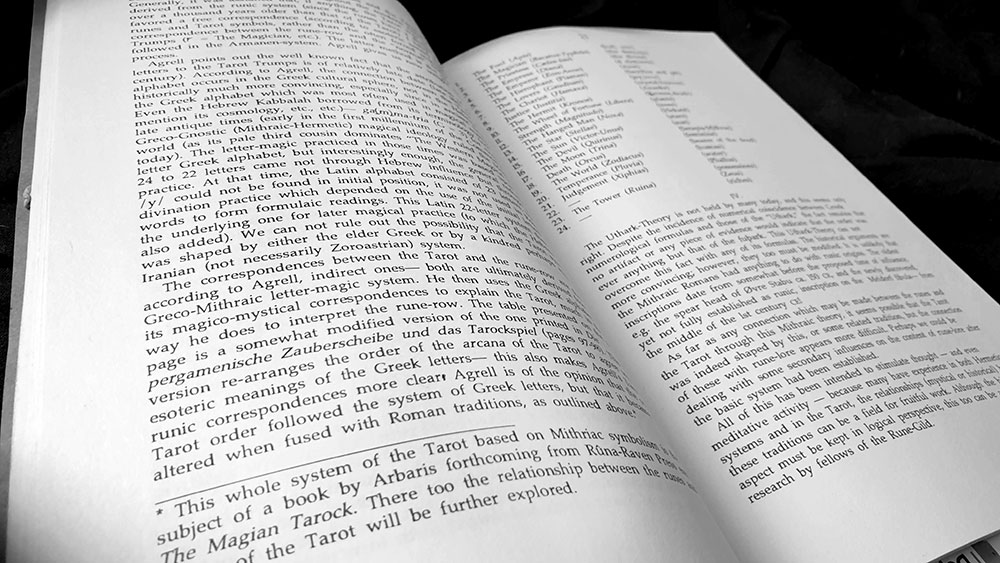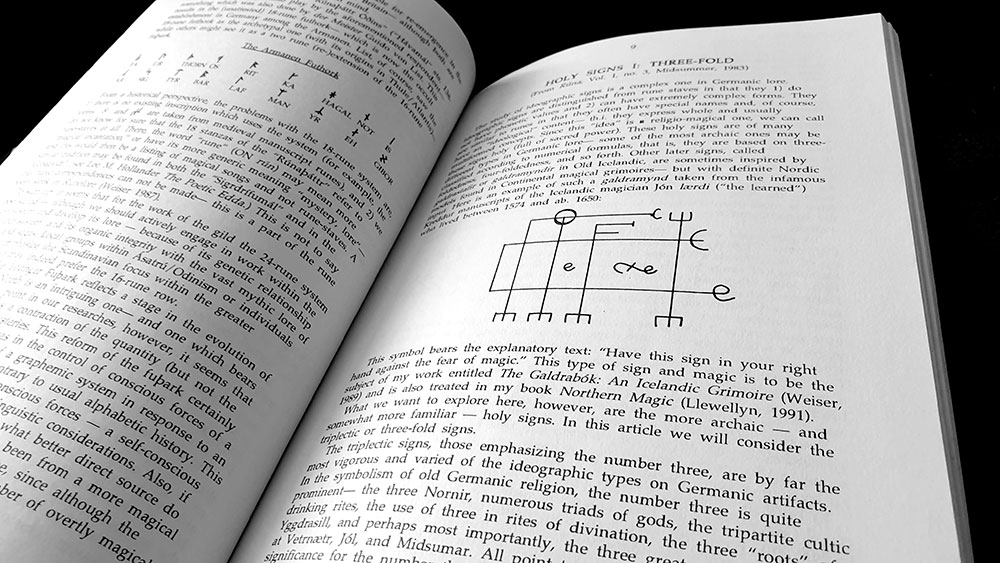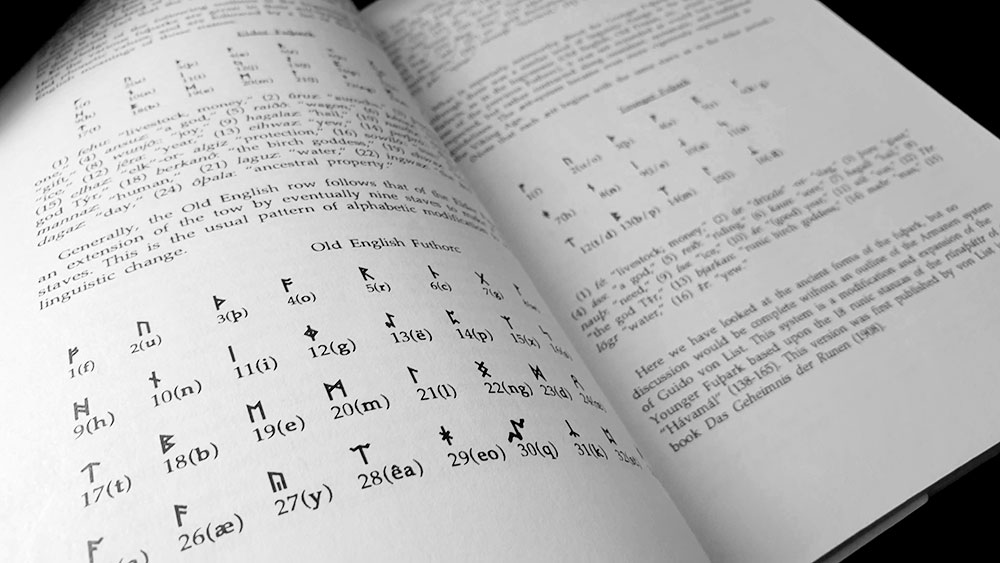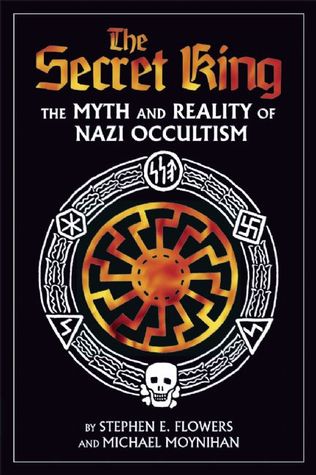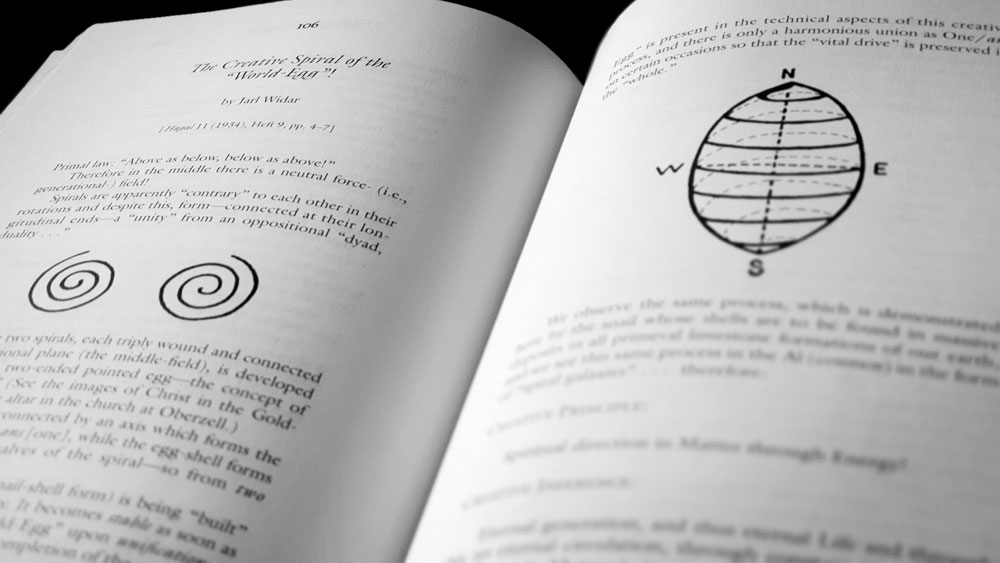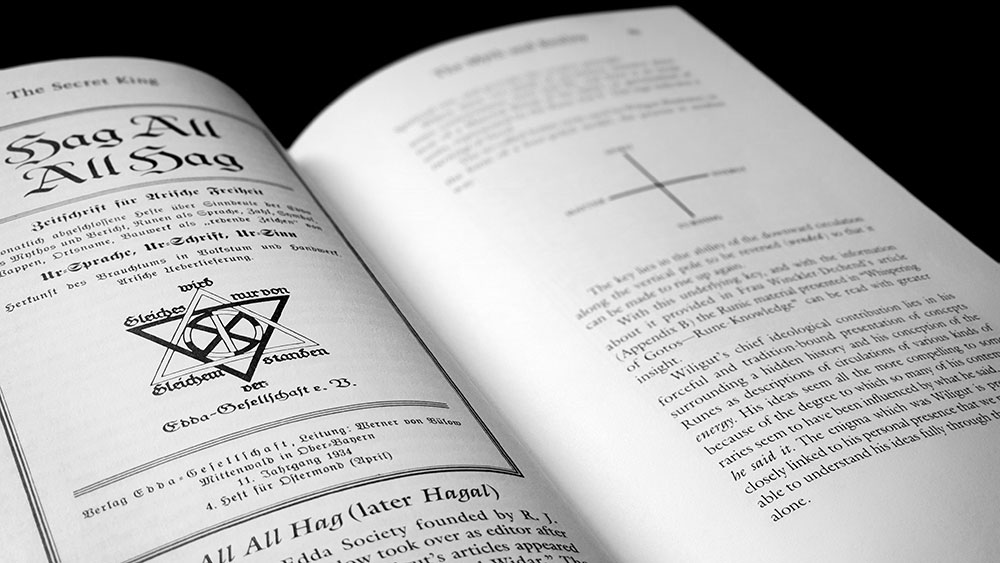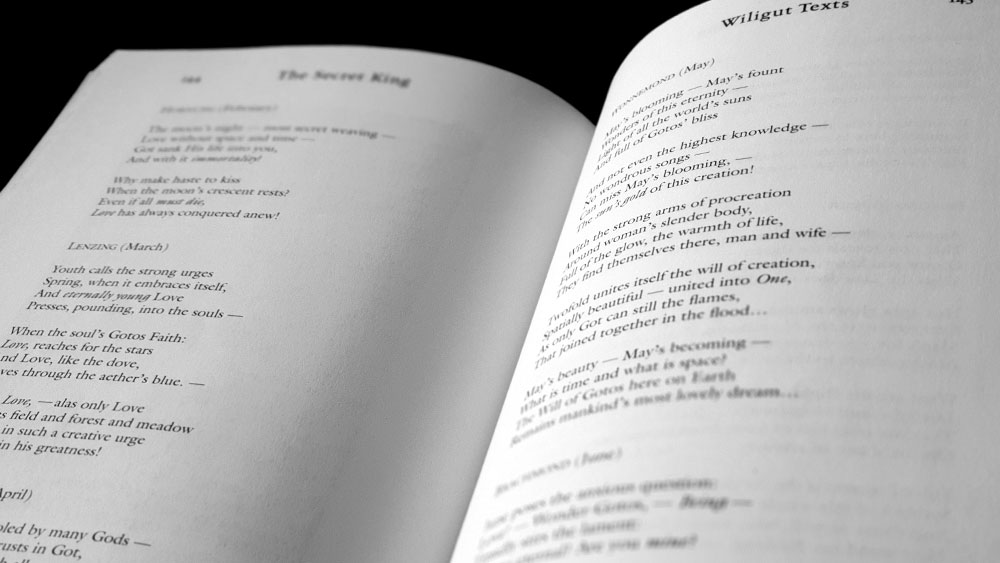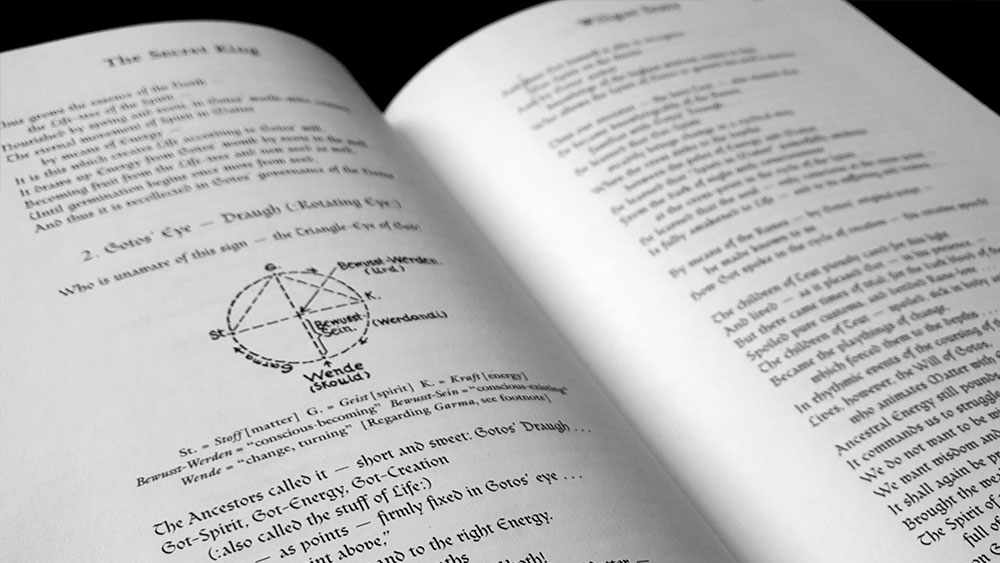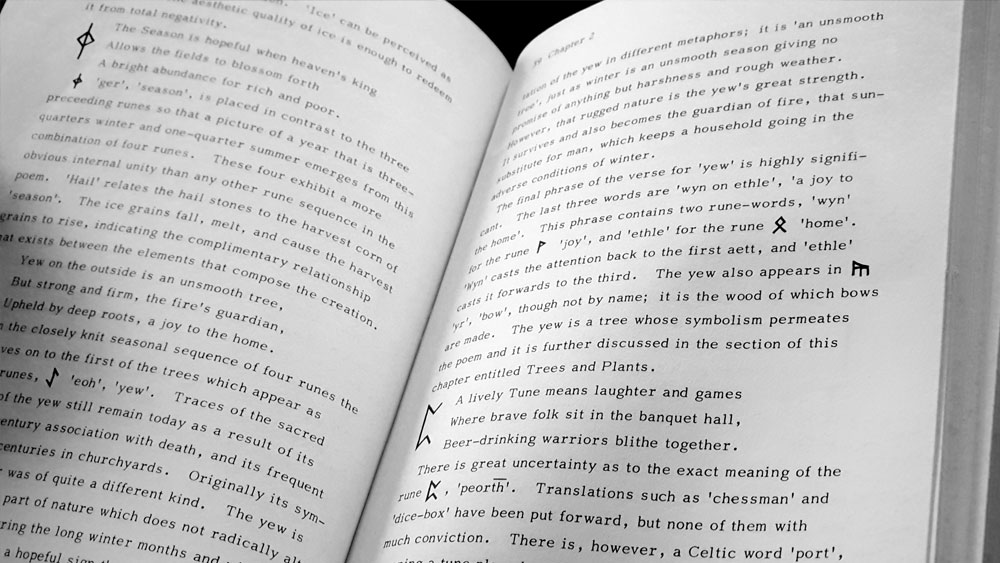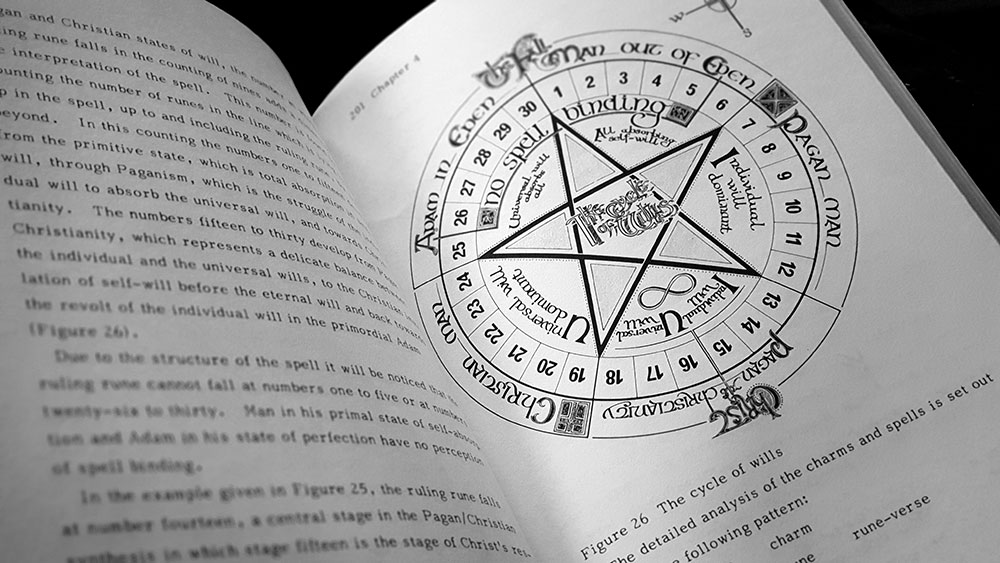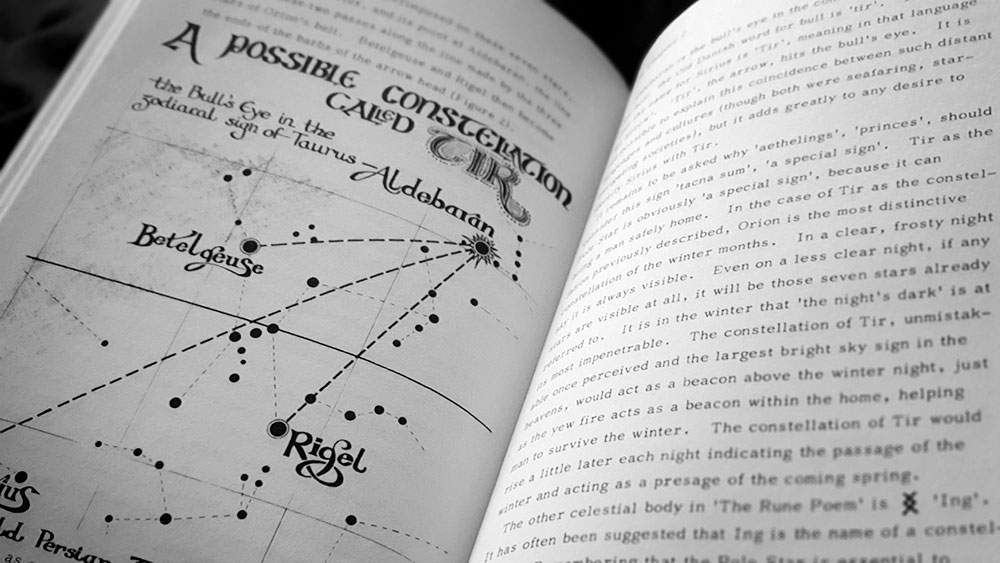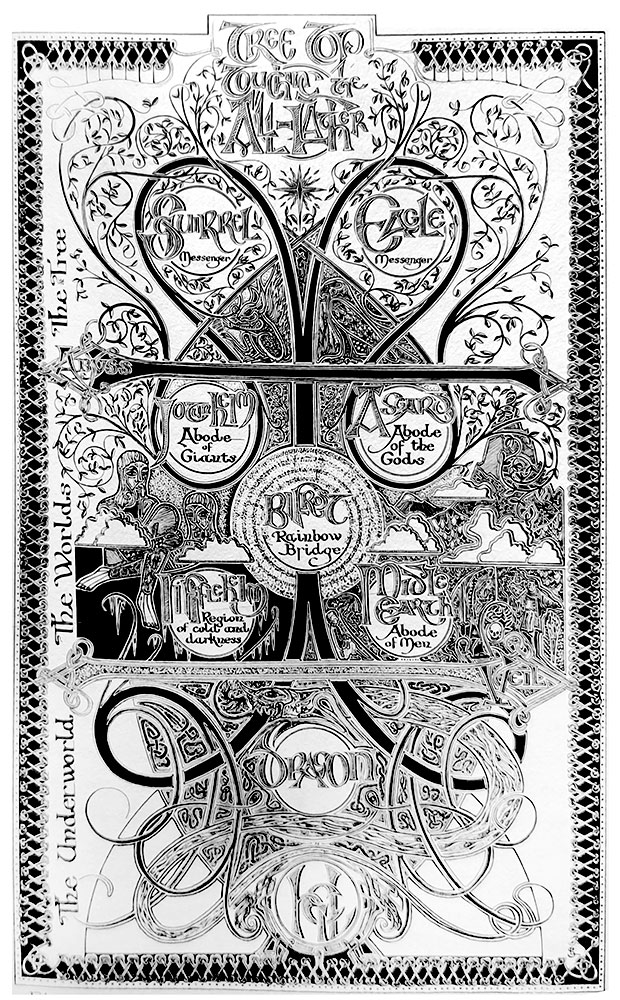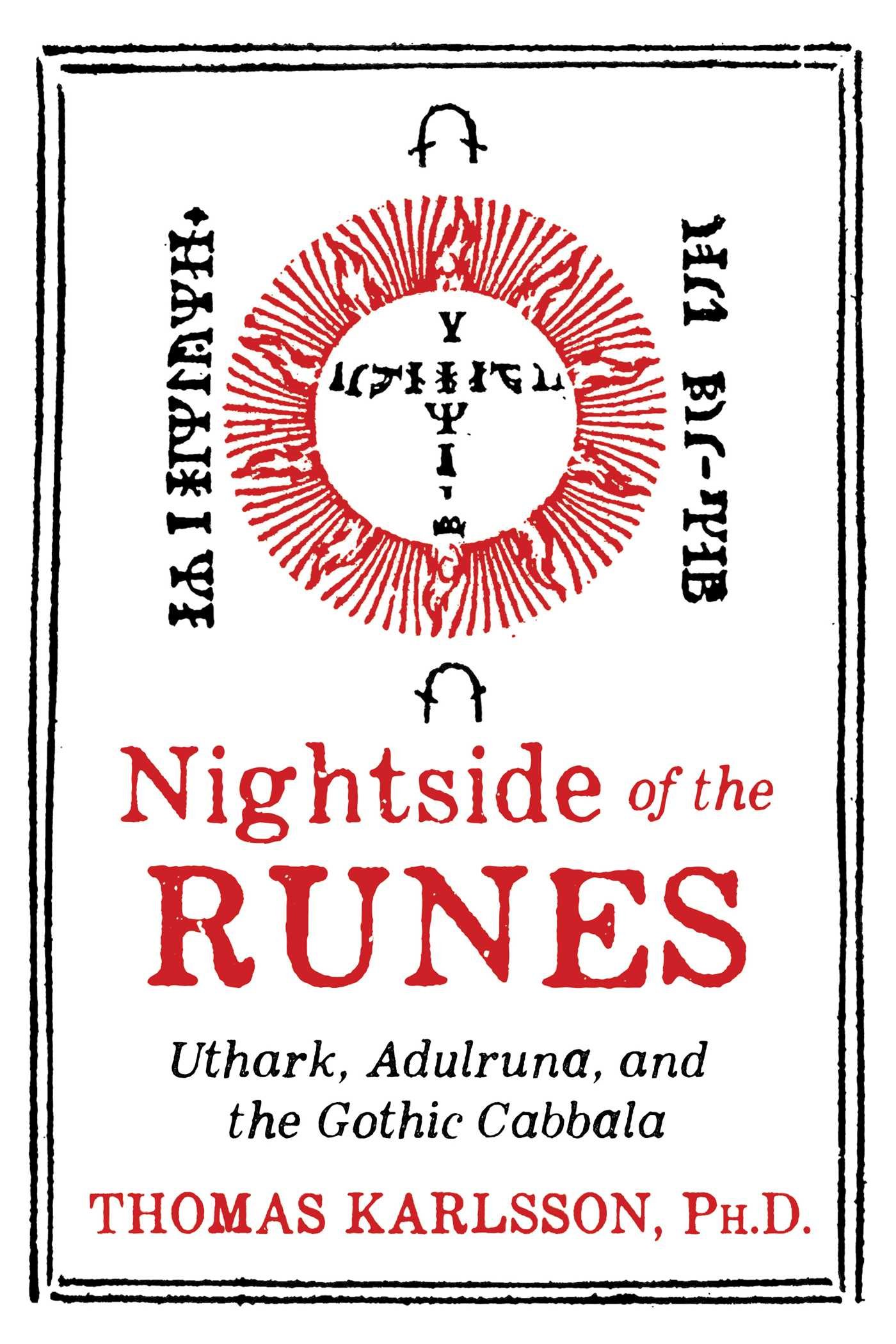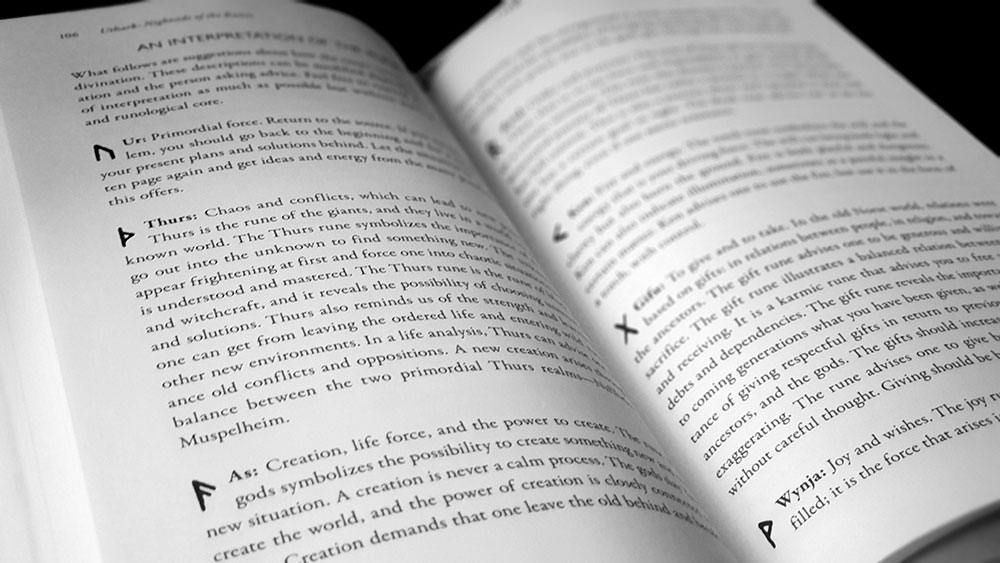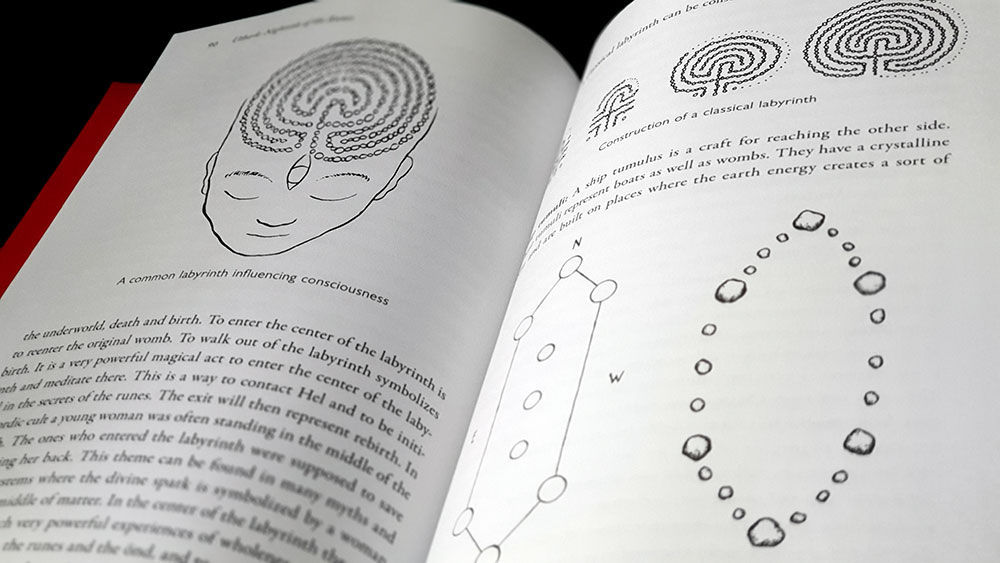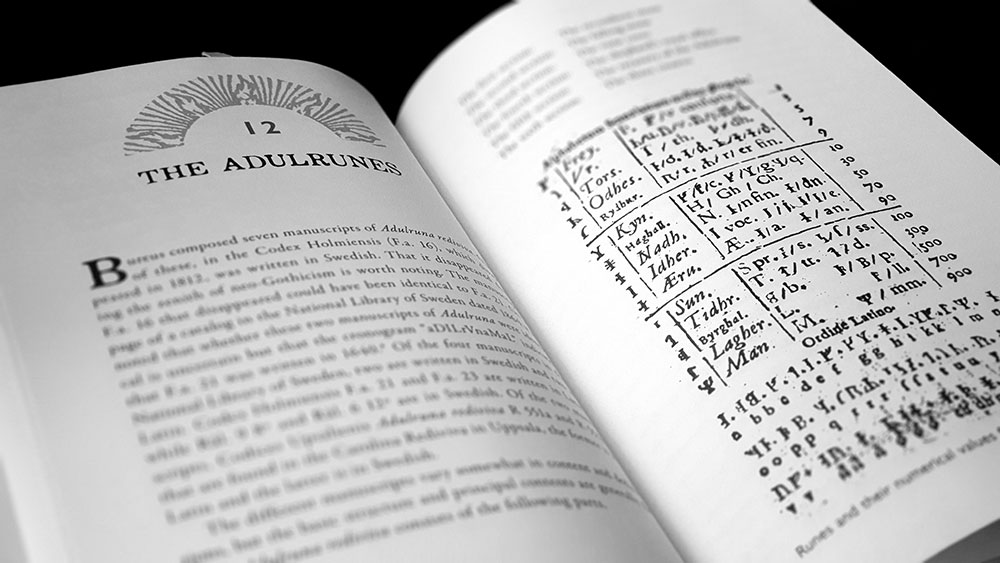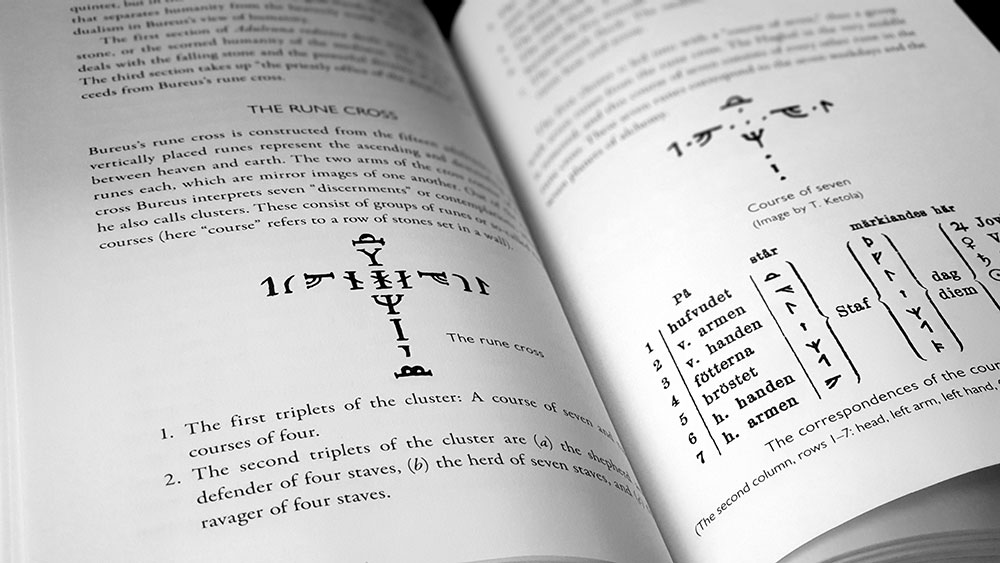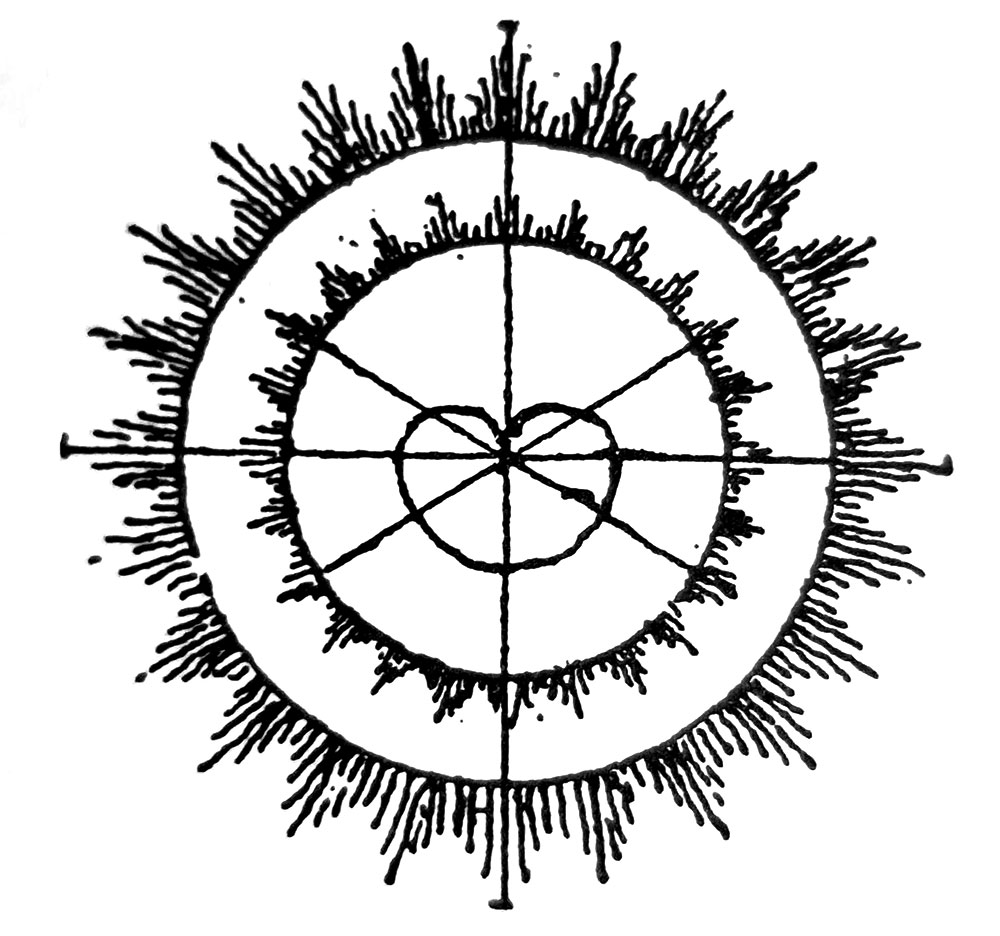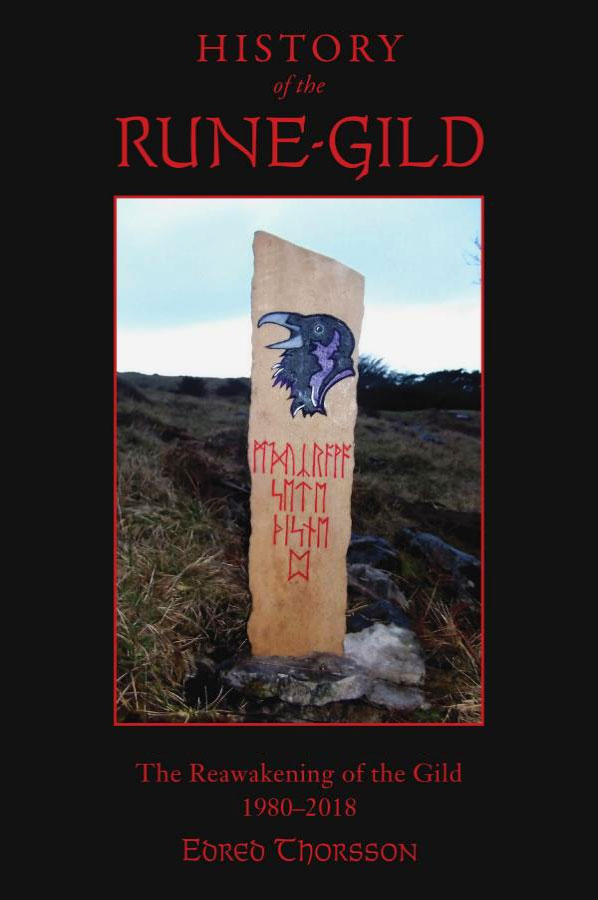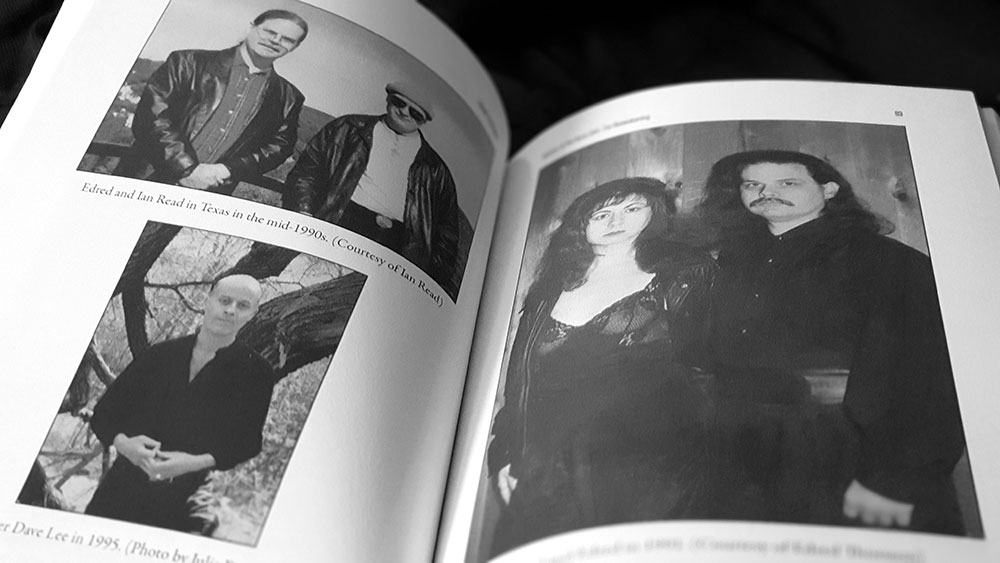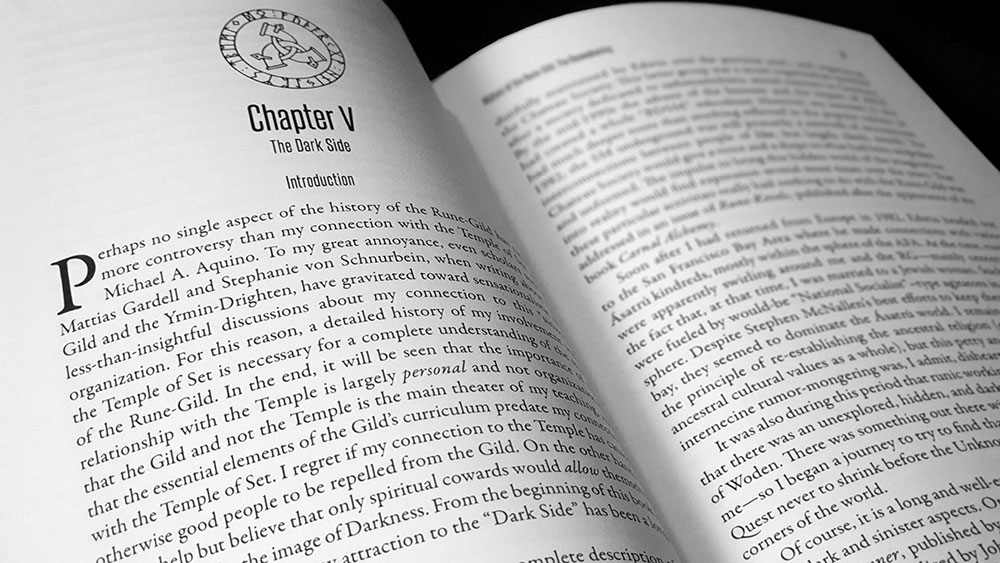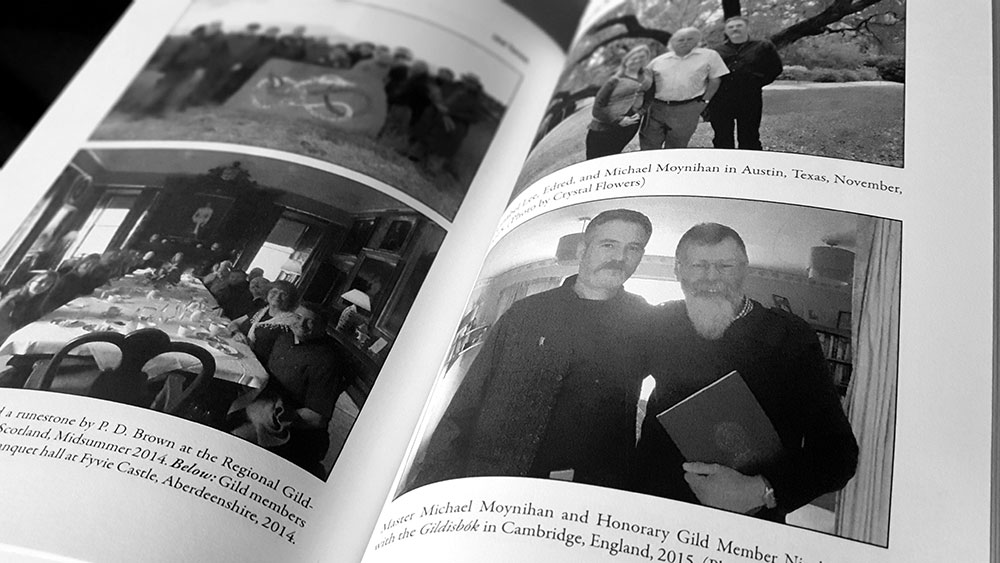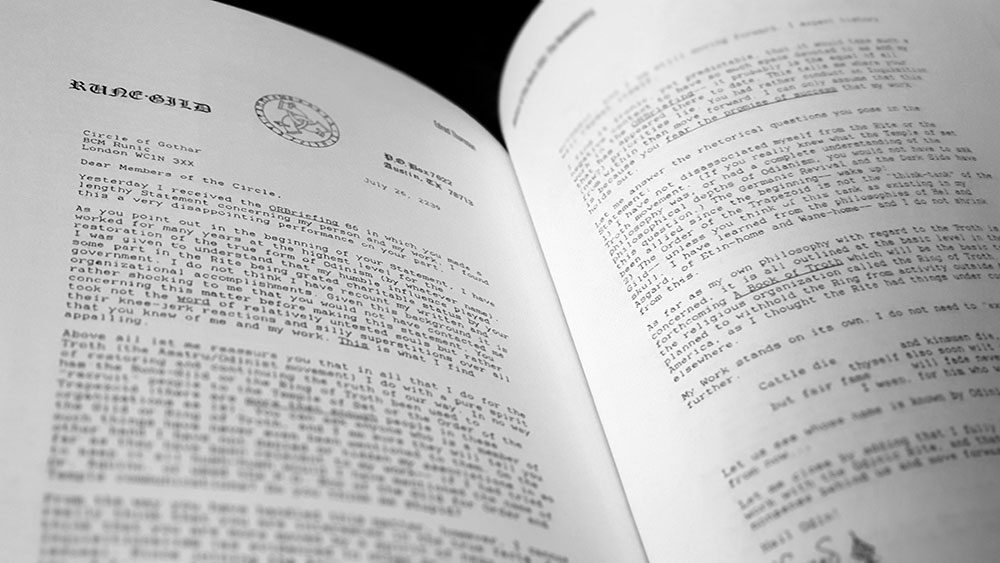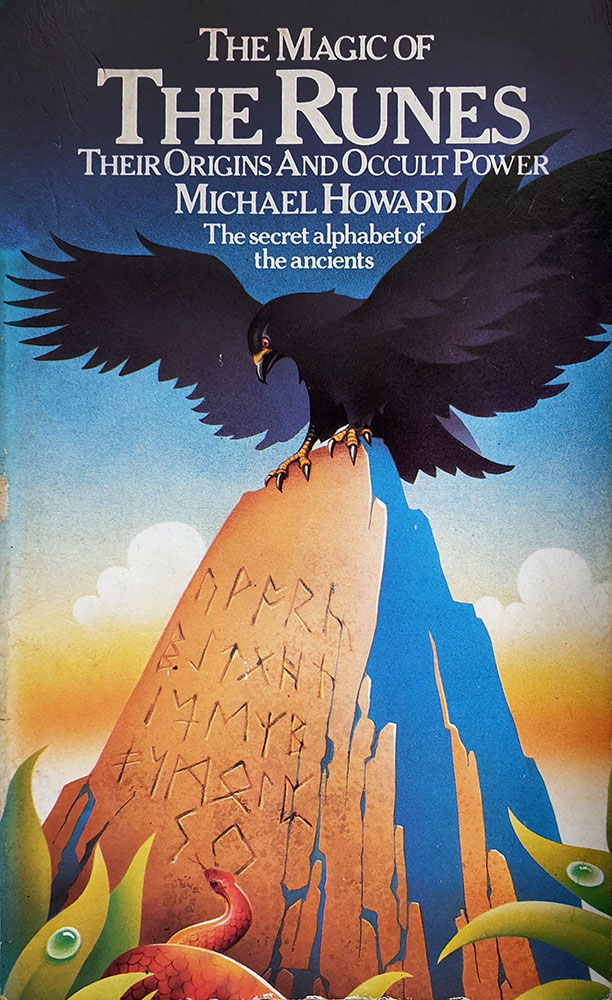 After it was savaged by Stephen Flowers in his recently-reviewed Revival of the Runes, your humble editor inevitably had to see whether it deserved such ire and retrieved this small book from some of the mustier shelves of the Scriptus Recensera. Published in 1980, The Magic of the Runes was one of Howard’s earliest books, emerging in the wake of his debut, Candle Burning: Its Occult Significance which he had written five years prior for Thorsons (that’s the publisher later bought by HarperCollins, not the pen name of Stephen Flowers). In 1980, Thorsons, via their imprint Aquarian Press, reissued Candle Burning and also published The Magic of the Runes, with both books sharing a similar design in which an identically formatted serif title sits atop lovely painted images. Both cover images, sadly uncredited, feel like major selling points for these titles, with a bright colour palette and surreal styling that evokes 1970s progressive rock album art, in particular the luminous gradients and impossible landscapes of Roger Dean who created the iconic cover art for the band Yes. In the case of The Magic of the Runes, an eagle, its wings spread, sits atop a runestone that with its dramatic shadows seems almost monolithic in scale, like a cosmic mountain, while at its base a serpent rises amongst leaves upon which lie gorgeously rendered drops of dew. The runestone faithfully bears the runes that are discussed within these pages, and therein lies the problem, and the source of Flowers’ ire.
After it was savaged by Stephen Flowers in his recently-reviewed Revival of the Runes, your humble editor inevitably had to see whether it deserved such ire and retrieved this small book from some of the mustier shelves of the Scriptus Recensera. Published in 1980, The Magic of the Runes was one of Howard’s earliest books, emerging in the wake of his debut, Candle Burning: Its Occult Significance which he had written five years prior for Thorsons (that’s the publisher later bought by HarperCollins, not the pen name of Stephen Flowers). In 1980, Thorsons, via their imprint Aquarian Press, reissued Candle Burning and also published The Magic of the Runes, with both books sharing a similar design in which an identically formatted serif title sits atop lovely painted images. Both cover images, sadly uncredited, feel like major selling points for these titles, with a bright colour palette and surreal styling that evokes 1970s progressive rock album art, in particular the luminous gradients and impossible landscapes of Roger Dean who created the iconic cover art for the band Yes. In the case of The Magic of the Runes, an eagle, its wings spread, sits atop a runestone that with its dramatic shadows seems almost monolithic in scale, like a cosmic mountain, while at its base a serpent rises amongst leaves upon which lie gorgeously rendered drops of dew. The runestone faithfully bears the runes that are discussed within these pages, and therein lies the problem, and the source of Flowers’ ire.
In 1980, knowledge of the runes within the esoteric milieu was in a nascent state, with both Ralph Blum’s The Book of Runes and Marijane Osborn and Stella Longland’s previously-reviewed Rune Games still two years away from being published, while Flower’s Futhark would not be released by Weiser until a further two years after them. Runic scholarship, such as it was, was still limited to the academy, and as a result, Howard did not have a lot to work with when he came to consider the subject in terms of references. It is not clear whether he consulted Ralph Elliott’s 1959 Runes: An Introduction, or R. I. Page’s An Introduction to English Runes from 1973. They’re certainly not referenced here, but then again, barely anything is.
The Magic of the Runes was, surprisingly, not Howard’s first foray into runes, having published the equally slight 95-page volume The Runes: And Other Magical Alphabets via both Thorsons and Weiser in 1978. Although Howard makes reference to that book here as a previous, standalone work, there are elements that make The Magic of the Runes feel like it may have been an updating of parts of its predecessor, with the two books sharing some identical chapter headings (The Origins of the Runes and The Runemasters) as well as the text hitting many of the same beats. There’s also the inclusion of at least one of the ‘other magical alphabets’ alluded to in the earlier title, with The Magic of the Runes concluding with a brief and somewhat superfluous chapter on Ogham.
Howard begins with a chapter whose title claims to be about the origin of the runes, but there’s very little philology here and instead this is more focused on the idea of Óðinn as the discoverer of the runes. From this basis comes a broader consideration of the cult of Óðinn and its potential analogies with shamanism, all painted with rather large strokes and infused with ideas heavily drawn from Manly Palmer Hall’s vision of a somewhat, if not entirely, theoretical Odinic Mysteries.
It is in the second chapter that Howard turns to the runes themselves and this is where things get weird. Here, Howard talks about how in his previous The Runes: And Other Magical Alphabets he had ‘rationalised’ the characters from various runic scripts into a single variant of the Germanic futhark, and that in order to avoid confusing the reader, that’s the version he sets out to use here. The care for the reader is a little misplaced, though, because the futhark he presents is, well, yes, confusing.
The runes are introduced in a double line block, with their Latin equivalent below each row, but for anyone with even just a passing familiarity with the runes, this must look a little off. While some of the characters are in the shape of conventional runes, others appear to have been taken from various Etruscan alphabets and other Old Italic scripts. Similarly, the attribution of Latin counterparts to these runes is all over the place, such as when a triple cross bar Hagalaz is transliterated to ‘n’, while something resembling Fehu is meant to be ‘w.’ It’s the runes themselves that suffer the worst, though, with the actual Fehu looking like a conventional capital Latin ‘F,’ or the equivalent of Uruz that seems to be a wonky capital ‘A,’ or the Raidho that looks nothing like an ‘R’ and instead is a triangular ‘D’. It’s unclear where some of these choices come from, whether it was simply poor research or an inattentive graphic designer who didn’t think the shape of these squiggles really mattered. Other character errors can be given a source, although it’s still baffling as to how they occurred, such as the rune given for ‘M’ which looks like a Latin ‘M’ but with one elongated stem. This glyph can be traced to the letter’s equivalent in various Etruscan scripts including Venetic, Camunic, Lepontic, all of which were derived from the Euboean version of the Greek alphabet, in which the same glyph occurs, as it does in many other archaic regional variations of the Greek alphabet, as well as in their ultimate root, Phoenician, where it is the letter mem. Something similar is true of the triangular D that is intended to be the equivalent of ‘R’ as this same attribution also occurs in Camunic, while the glyph is seen in Phoenician too, though there, just to be difficult, it’s the letter daleth, the equivalent of the Latin ‘D.’ Perhaps the most confusing of these misplaced letters is the equivalent of Þ which just looks like someone got carried away whilst drawing a ‘B’ and added too many bowls, if you’ll forgive the typographic nomenclature.
The result flies in the face of Howard’s description of this set as a rationalised Germanic futhark, having as much in common with Greek and Phoenician as it does with anything Germanic, and being, for that matter, not all that rational. What makes this rationalised futhark all the more puzzling is that Howard immediately follows its introduction with what is now a very standard format for rune books in which the glyph of a rune is shown, its name is given, and then a little paragraph or so of meaning and context is provided. But the runes here are different from the rationalised ones in the image immediately above, and instead mirror the Elder Futhark, well, kind of. The names given for each rune are largely the Anglo-Saxon ones, but out of the gate things go awry when Feoh with its associations with cattle and wealth is not the familiar F-like glyph but is instead an inverted arrow or Tir rune. Still, it fares better than Ur, which is completely forgotten and replaced by a premature Beorc, which at least has the right glyph. Then Þ starts off badly with its Anglo-Saxon name rendered not as Ðorn but as Porn, ooh matron, but it gets worse, if such a thing is possible, when the glyph is not the entire thorn shape but just the triangular D that was attributed to ‘R’ in the previous rationalised futhark. The futhark gets back on track order-wise for Os, Rad, Ken, although almost expectedly, Os uses the shape of the Elder Futhark Ansuz (or the Anglo-Saxon Æsc), rather than the winged Os of the Anglo-Saxon futhorc. Further along, Eoh looks more like a broken tick symbol, barely related to the familiar Eihwaz double hook, while Peorð is charmingly referred to as Pear and its glyph is once again not quite right. In all, there are twenty-one runes listed here, with Ur, Is and Eh being omitted for some reason, while the additional four runes that are unique to the Anglo-Saxon futhorc are also absent.
In all, this makes for a very confusing experience, where it’s not clear why some of the runes are rendered as they are, or why some are missing, or, of course, why there is the disconnect between the rationalised futhark Howard presents at the start and the runes that are described in the pages that immediately follow it. It doesn’t end there, though, and later on things get further muddled when Howard gives some practical uses for the runes. First, in a piece on writing runes as charms he acknowledges that because the rationalised futhark he is presenting doesn’t have the letters for ‘Y’ and ‘E’ (which, yes, is what’s going to happen if you arbitrarily remove runes from a script) then the practitioner should replace those letters in a formulae with a sigil for the Sun. There’s no explanation as to why the astrological symbol for the Sun should be an appropriate substitute, but it certainly creates a very un-runic looking sequence, what with all these perfect circles amongst angular runes. The example he gives then goes to town with sun circles, using it in place of not just ‘e’ but also the ‘H’ and ‘T’ he’s left out of his rationalised futhark, as well as using two of these circles for ‘TH’ when he could have used his multi-bowl equivalent of Þ. Such is the ambiguity that in another example, in which upright and inverted interpretations of the runes are listed for divination, it’s not clear whether he’s using his rationalised futhark or the truncated Anglo-Saxon futhorc, because the runes come from both, whilst leaving out some, such as the rationalised multi-bowl Þ or an equivalent for ‘Z’ which is entirely his own but looks like Óss, the Younger Futhark version of Ansuz.
These errors or quirks are documented so thoroughly here because of just how fascinating and inexplicable it all is. It’s impossible to really work out what led to these choices, whether there was some source material that was already garbled, or whether things got messy during the process of either writing or formatting the book. Not to mention whether editors at The Aquarian Press thought anything of it, or whether they just pressed print as their eyes glazed over. These are particularly germane concerns given that Howard specifically mentions the idea of writing the runes correctly, as exemplified in the story of the runemaster Egill Skalla-Grímsson, who would probably be apoplectic were he to come across this book. Skalat maðr rúnar rísta,nema ráða vel kunni indeed.
In both his definition of each rune and the general discussions elsewhere in this book, Howard has a style that belies the lack of sources he must have accessed to at the time. Things are painted pretty broadly with only rare recourse to actual sources, and when such writers are cited, much hay is made from them, with P. V. Glob, Margaret Murray, James Frazer, Lewis Spence, Manly Palmer Hall, and Robert Macoy (via Palmer) all being put to thorough use. Some of Howard’s descriptions and statements seem a little off or reflective of the now-outdated preconceptions held by his non-specialist sources: such as the prominence given to the idea of the sun being associated with gods and the moon with goddesses, when the reverse was true in Germanic cosmology, or the idea of Loki as a god of fire, or Baldur as a solar one. Indeed, Howard’s approach is a precursor to the type of writing he would use in later decades, having a broad approach and encyclopaedic knowledge that allows him to refer to multiple examples, though often without direct referencing, with a teasing out similarities betwixt different areas and eras to imply a coherence that is pleasing but which may, with a greater scrutiny, not really be there.
Despite the quibbles over the non-specialised tone, there’s nothing too egregious within these pages, and in many ways, Howard’s style predicts the content of books to come, where the Norse world is often described in a largely imaginary and idealised way, with imagery writ large, ambiguity shaved off, and with little recourse to academic sources for anything more than a cursory understanding. Indeed, on a wider level, The Magic of the Runes appears as a template for many of the rune books that would follow in its wake. There’s the step by step explanation of each rune, along with a list of some of the gods and their simplified traits or specialities, a couple of examples of practical applications for the runes, a little bit about other related symbols or sigils, a list of auspicious dates or festivals, an invocation or two, and a reprint of source texts, such as the Ljóðatal section of Hávamál, for a little taste of authenticity.
The Magic of the Runes marks a significant point in the modern development and awareness of the runes and makes for an interesting historical document in and of itself, even if the actual historicity it depicts in highly questionable. Its slight 96 pages of yellowing newsprint are presented at foolscap octavo size which fits easily in one hand, with perfunctory formatting, as one would expect for the time. Howard would once again return to the runes in 1985 with The Wisdom of the Runes, a considerably longer work that had slightly more rigour to it. It clearly builds on The Magic of the Runes, using entire sections from its predecessor and rewriting them, but it mercifully reverts to a standard Elder Futhark with no errant Etruscan or Greek letters, and no sun symbol subbing for excised runes. It does add the dreaded blank rune to its discussion, three years after it was notoriously introduced to the wider public by Blum in The Book of Runes (which is not cited here), with Howard referring to it as the Wyrd Rune, perhaps the first use of that name for it.
Published by The Aquarian Press.
